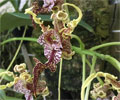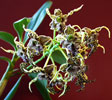|
|
|
|
|
| |
Flasks of
Dendrobium spectabile 'MC7003' × 'Bone II' |
|
| |
|
|
| |
| Number: |
TN8098 |
| Name: |
Dendrobium spectabile 'MC7003' × 'Bone II'
|
| Type: |
outcross (What's that?) |
|
Seed Donor: |
Troy C. Meyers
|
|
Click to Enlarge

Pod Parent Flower |
Click to Enlarge

Pollen Parent Closeup of Flower |
Click to Enlarge

Pollen Parent Flowers |
|
|
|
| |
Culture Notes from Donor: Pollen parent plant: Temperature range I (60-83°F)
Comments: Pod parent plant: One of the offspring from our TN4176 effort of 2004.
For additional origin/habitat information supplied courtesy of
Charles and Margaret Baker, see further below, near the bottom of this page.
|
Temperatures we attempt to use in the lab & greenhouse:
| For Species: |
|
Spring, Summer, Autumn, Winter: days average 87°F, nights 68°F; best fit is Warm-Intermediate 87-64°F
(Source:
Baker's Web OSC) |
|
About the name...
| Etymology of |
Dendrobium |
|
From Greek "dendron" tree and "bios" life.
(Source:
Pridgeon 1992) |
| Etymology of |
spectabile |
|
From Latin "spectabilis" notable, showy.
(Source:
Brown 1956) |
| Pronunciation of |
Dendrobium |
|
den-DRO-bee-um
(Source:
Pridgeon 1992) |
| Pronunciation of |
spectabile |
|
spek-TAH-bi-lee
(Source:
Hawkes 1978) |
|
If you would like to direct someone to this web page, please copy and paste this URL into your email:
http://troymeyers.com/d?018098
| Flask Information |
| Availability: |
We have sold all of the flasks for this item. |
| You should: |
Consider getting individual plants or compots instead of a flask.
You can place a "Notify Flask Recipients" Request, and either we or a flask recipient may contact you when plants are available.
You may also place a "Notify Retries" Request, and if an identical pollination (the same parents) is done again, we'll let you know.
You may reserve a flask, but it's very unlikely you'll get one ...this could only happen if we found a flask that we didn't know we had. |
| Yield Estimate: |
580 plants (based on flask surveys done 01/21/2016 through 04/04/2019)
|
| Plantlet Sizes: |
From many flasks 5 - 80 mm plants (based on flask surveys done 01/21/2016 through 03/08/2019)
From one most recently surveyed flask 30 - 70 mm (03/08/2019)
|
|
You might also want to:
|
View the seed assay for this item.
View items of the same species.
View items of the same genus.
|
| Ordering Information |
| You are not currently logged in. |
|
You must be a registered user and be logged in to reserve a flask or place a notification request. Please log in:
|
|
|
|
|
|
| |
The origin/habitat information below is supplied courtesy of Charles and Margaret Baker
The following information is based on the name of the plant provided by the donor, and assumes that the name is correct. If the plant has been misidentified, then the following information may not be correct.
This text is copyrighted by the Bakers and may not be reproduced without permission.
ORIGIN/HABITAT: New Guinea, Bougainville, the Solomon Islands, and
Vanuatu. Plants grow on trees in swampy lowland forests, lower mountain
forests, or in planted coconut or Casuarina trees from sea level to 3600
ft. (0-1100 m). On ridge tops, they grow on the surface of the ground in
thick moss and peat. The plants survive exposure to high light and hot
temperatures at lower elevations, but they are more abundant in cool,
shady locations at higher elevations.
More about this information and the Bakers...
|
|
|
| |
|
|
|